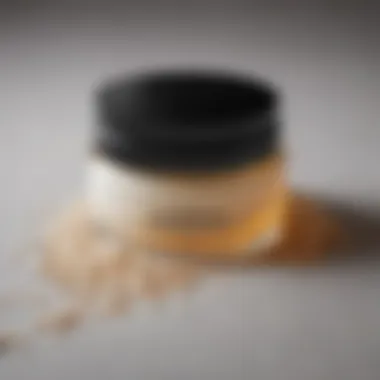Top Chemical Exfoliants for Acne-Prone Skin


Intro
Chemical exfoliants have gained notable attention for their effectiveness in treating acne-prone skin. These agents work by removing dead skin cells, unclogging pores, and reducing inflammation. Both alpha hydroxy acids (AHAs) and beta hydroxy acids (BHAs) are popular choices. Understanding their properties can help users make better-informed decisions on their skincare routines.
This comprehensive guide aims to elucidate the best chemical exfoliants tailored specifically for those facing acne challenges. We will explore how these products work and the importance of incorporating them into a standardized skincare regimen. Additionally, the guide seeks to navigate potential risks and highlight safe usage practices.
Following the guide, readers can expect to find expert recommendations and must-know tips for maintaining clear and healthy skin.
Understanding Acne-Prone Skin
Understanding acne-prone skin is essential for selecting the right skincare treatments. This section explores the defining characteristics of acne-prone skin, its common causes, and the role of exfoliation in managing it. By gaining insights into these elements, readers can make informed choices and enhance the effectiveness of their skincare routines.
Characteristics of Acne-Prone Skin
Acne-prone skin is typically characterized by the presence of excess oil, clogged pores, and inflammation. People with this skin type often experience breakouts in various forms, including blackheads, whiteheads, and cystic acne. Other signs may include redness and sensitivity. Individuals with oily skin, larger pores, and a tendency to develop blemishes are often categorized as having acne-prone skin.
It is important to note that acne can affect people at any age, not just teenagers. Hormonal fluctuations, such as those related to menstruation or stress, can contribute to the severity of symptoms in adult women.
Common Causes of Acne
The causes of acne are multi-faceted. Hormones, especially androgens, play a significant role. Androgens increase oil production in the skin, leading to an overgrowth of skin cells and clogged pores.
Other common contributors to acne include:
- Genetics: Family history of acne can increase susceptibility.
- Diet: Certain foods, particularly those high in refined sugars and dairy, may exacerbate breakouts.
- Environmental factors: Pollution and humidity can affect skin health.
- Skincare products: Some comedogenic products may clog pores and worsen acne.
Role of Exfoliation in Acne Management
Exfoliation is crucial for managing acne-prone skin. It helps remove dead skin cells that can contribute to clogged pores and blackheads. Regular exfoliation encourages cell turnover, which can improve skin texture and promote a clearer complexion.
Chemical exfoliants, such as alpha hydroxy acids (AHAs) and beta hydroxy acids (BHAs), are particularly effective. They penetrate the skin and help dissolve the bonds holding dead skin cells together, making them easier to wash away. This process not only aids in preventing breakouts but also enhances the overall appearance of the skin.
Regular exfoliation can significantly improve the clarity and texture of acne-prone skin, making it a vital part of skincare routines.
Chemical Exfoliants Explained
Chemical exfoliants play a crucial role in the realm of skincare, especially for those with acne-prone skin. These substances are designed to dissolve dead skin cells and enhance cell turnover. By doing so, they help in maintaining a clearer complexion and reducing the likelihood of breakouts. Understanding chemical exfoliants enables individuals to make informed choices regarding their skincare routines.
What Are Chemical Exfoliants?
Chemical exfoliants are agents that facilitate the removal of dead skin cells through chemical reactions. Unlike physical exfoliants, which rely on abrasive particles for scrubbing away skin impurities, chemical exfoliants use acids or enzymes to achieve the same goal. Common examples of these chemical exfoliants include Alpha Hydroxy Acids (AHAs) and Beta Hydroxy Acids (BHAs).
AHAs, such as glycolic and lactic acid, are derived from natural sources like fruits and milk. They are water-soluble compounds, effective for improving surface texture and promoting hydration. On the other hand, BHAs like salicylic acid are oil-soluble, allowing them to penetrate deeper into the pores. This characteristic makes them particularly effective for acne-prone skin, as they help unclog pores and reduce inflammation.
Difference Between Chemical and Physical Exfoliation
Understanding the difference between chemical and physical exfoliation is essential in choosing the right method for skincare.
- Chemical Exfoliation: This method involves the use of acids or enzymes that chemically break down the bonds holding dead skin cells together. It is generally gentler on the skin and can reach deeper layers without the potential irritation caused by abrasives.
- Physical Exfoliation: This technique uses mechanical means, such as scrubs or brushes, to physically scrub away dead skin cells. While it can provide immediate results in terms of smoother skin, it risks micro-tears and irritation, particularly for sensitive or acne-prone skins.
"Choosing the right exfoliant is key to achieving healthy and clear skin."
In summary, chemical exfoliants offer a gentler yet effective alternative to their physical counterparts. They can deliver significant benefits for those with acne-prone complexions, enhancing overall skin texture and reducing the chances of breakouts.
Types of Chemical Exfoliants
Understanding the different types of chemical exfoliants is essential for anyone dealing with acne-prone skin. These exfoliants function at a deeper level than physical exfoliants, providing targeted treatment. They help in clearing clogged pores, reducing inflammation, and improving skin texture. Each type has unique characteristics that suit various skincare needs. Knowing these differences allows individuals to choose the most effective products for their specific issues. This section explores Alpha Hydroxy Acids, Beta Hydroxy Acids, and other exfoliating agents.


Alpha Hydroxy Acids (AHAs)
Common Types of AHAs
Alpha Hydroxy Acids are water-soluble acids derived from fruits and milk. The most common types include glycolic acid, lactic acid, mandelic acid, and citric acid. Glycolic acid, extracted from sugarcane, is notably popular due to its small molecular size, allowing for deeper penetration into the skin. Each type of AHA carries its unique profile, but they all share a fundamental attribute: they are effective in improving skin texture and removing dead skin cells. This makes AHAs a favorable choice for those looking to maintain clear skin, particularly in cases of mild to moderate acne.
Benefits for Acne-Prone Skin
AHAs are well-regarded for their ability to enhance skin cell turnover. This characteristic is crucial in acne management, as it can prevent the build-up of dead skin cells that often clog pores. Additionally, AHAs possess hydrating properties, primarily lactic acid, making them suitable even for sensitive skin types. Another benefit is their potential to reduce discoloration and improve overall skin tone, which is often a concern for those with acne scars. Thus, AHAs serve a beneficial role in a comprehensive approach to treating acne-prone skin.
Potential Side Effects
While AHAs offer numerous benefits, it is important to be aware of potential side effects. These may include irritation, redness, and increased sun sensitivity. Individuals with sensitive skin may experience adverse reactions even at low concentrations. It is critical to introduce AHAs gradually into your skincare routine to monitor how your skin responds. Awareness of these side effects allows users to make informed decisions and adjust usage accordingly, ensuring a safe and effective exfoliation experience.
Beta Hydroxy Acids (BHAs)
Characteristics of Salicylic Acid
Salicylic acid is the most recognized BHA and is oil-soluble. This property enables it to penetrate the oil in the pores, making it particularly effective for acne-prone skin. Salicylic acid reduces inflammation and does not just remove dead skin; it also helps prevent new acne from forming by keeping pores clear of debris. Its anti-inflammatory properties make it a staple for those dealing with active breakouts, providing visible results in a short period.
How BHAs Help Clear Pores
BHAs like salicylic acid work by exfoliating the inside of the pores, offering a deep clean that AHAs cannot achieve. This ability to penetrate oily skin is crucial for acne sufferers, as blocked pores can lead to breakouts. Over time, the regular use of BHAs can lead to fewer blackheads and whiteheads, contributing to a clearer complexion. Their efficacy in targeting both acne and blackheads marks BHAs as a valuable component in any skincare regimen aimed at managing acne.
Who Should Use BHAs?
BHAs are particularly suitable for individuals with oily and acne-prone skin types. Unlike AHAs, which may be better for those with dry skin, BHAs directly target excess oil production. However, everyone can benefit from incorporating salicylic acid to some extent. It's vital for users to assess their skin’s tolerance and start with lower concentrations, especially if they have irritated or sensitive skin.
Other Exfoliating Agents
Retinoids
Retinoids, which are derivatives of vitamin A, play a multifaceted role in acne treatment. They promote rapid skin cell turnover and help prevent clogged pores. Additionally, retinoids can fade post-acne marks and improve skin texture over time. They are considered a powerful ally in a skincare routine for acne-prone skin. Users should be cautious and start slowly, as they can cause irritation.
Enzymatic Exfoliants
Enzymatic exfoliants, such as those derived from fruits like papaya and pineapple, offer a gentle alternative to AHAs and BHAs. They work by breaking down the bonds holding dead skin cells together, promoting a natural shedding process. This makes them suitable for sensitive skin types and individuals seeking a mild approach to exfoliation. While they may not be as potent as chemical exfoliants, they can still contribute positively to skincare routines aimed at achieving a clearer complexion.
Choosing the Best Chemical Exfoliant
Selecting the right chemical exfoliant is crucial for effectively managing acne-prone skin. Not all exfoliants work the same way, and understanding how to choose the best one can significantly influence skincare outcomes. A well-chosen exfoliant can promote clearer skin, minimize breakouts, and enhance overall skin texture. It's essential to focus on several factors when making this choice, including individual skin types, ingredient concentrations, and safety measures.
Assessing Your Skin Type
Understanding your skin type is the first step in choosing an appropriate chemical exfoliant. Skin can be classified into different categories: oily, dry, combination, or sensitive. Each category requires a different approach to exfoliation.
- Oily skin might benefit from beta hydroxy acids like salicylic acid, which helps penetrate pores and reduce excess sebum.
- Dry skin should lean towards alpha hydroxy acids, such as glycolic acid, to promote hydration while exfoliating.
- Combination skin may need a balanced approach, utilizing both AHA and BHA products at different times.
- Sensitive skin requires extra caution. Look for gentle formulations and always perform a patch test before full application.
In assessing skin type, consult with a dermatologist if necessary. Understanding specific needs helps prevent irritation and enhances the effectiveness of the chosen exfoliant.
Concentration Matters
When it comes to chemical exfoliants, the concentration of active ingredients plays a critical role in efficacy and safety. Many products come in varying concentrations, and each level is suitable for different skin types and concerns.
Lower concentrations can be more appropriate for beginners or sensitive skin types:
- Glycolic acid: 5-10% may be good for initial use.
- Salicylic acid: 0.5-2% is standard for acne treatment.


Higher concentrations can cause irritation if not used correctly, so it is wise to start low and gradually increase. Many products recommend patch testing—applying a small amount to an inconspicuous area—to gauge your skin's response before full application.
Patch Testing for Safety
Patch testing is an essential practice when introducing any new skincare product, particularly chemical exfoliants. This process helps identify potential allergic reactions or sensitivities before spreading the product across the entire face.
To conduct a patch test:
- Choose a small area on your inner arm or behind your ear.
- Apply a small amount of the exfoliant and wait 24 hours.
- Observe for any adverse reactions, such as redness or irritation.
If there's no reaction, the product is more likely safe for facial use. If irritation occurs, it's best to discard the product or consult a dermatologist. Safety should always come first to ensure a positive skincare experience.
"Choosing a chemical exfoliant is not just about effectiveness; it requires a thorough understanding of your skin's unique needs."
Implementing a Skincare Routine
Implementing a skincare routine is crucial for managing acne-prone skin effectively. This structured approach not only aids in maintaining skin health but also enhances the results obtained from using chemical exfoliants. A well-thought-out routine enables the skin to adapt gradually, reducing the risk of irritation that can arise from sudden changes in skincare products. Moreover, establishing a consistent regimen cultivates long-term improvements, fostering a balanced and clear complexion.
Frequency of Use
When incorporating chemical exfoliants into your skincare routine, frequency of use is perhaps the most important consideration. Striking the right balance is essential; too much exfoliation can lead to irritation while too little may not provide the desired results. A general guideline is to begin with one or two applications per week, depending on the product's strength and your skin's overall tolerance.
As the skin acclimates, one can gradually increase the frequency to three or four times a week. However, it is wise to observe how your skin responds. Redness or excessive peeling can indicate that you are overdoing it. If this occurs, dial back to a less frequent schedule. Sustained use over time often yields better results than sporadic applications.
Combining Exfoliants with Other Ingredients
Effective use of chemical exfoliants also involves understanding how to combine them with other ingredients in your skincare products. Many individuals utilize serums, moisturizers, and other treatments alongside exfoliants. It is crucial to know that while certain ingredients work harmoniously, others may counteract the benefits of exfoliation.
For instance:
- Hyaluronic Acid complements the hydrating aspects of exfoliation, preventing dryness and maintaining moisture levels.
- Vitamin C can enhance the brightening effects post-exfoliation without causing irritation when used appropriately.
- Retinoids may provide additional anti-aging benefits but should be used carefully, as combining them with alpha or beta hydroxy acids can increase sensitivity.
Learning the appropriate combinations can significantly enhance the efficacy of your routine, allowing your skin to harness the full benefits of each ingredient.
Moisturizing and Sun Protection
Lastly, focusing on moisturizing and sun protection cannot be overstated. Chemical exfoliants can make the skin more susceptible to UV damage. Thus, applying a broad-spectrum sunscreen daily is a critical step, regardless of the season. Look for sunscreens with an SPF of at least 30.
Additionally, using a good moisturizer after exfoliation is vital for recovery. A proper moisturizer helps replenish products and counteracts dryness that may result from exfoliation. Products featuring ceramides and glycerin are often recommended, as they help strengthen the skin barrier and retain moisture.
Recommended Chemical Exfoliants for Acne-Prone Skin
Selecting the right chemical exfoliant is crucial for individuals with acne-prone skin. These exfoliants can aid in unclogging pores, reducing inflammation, and promoting cell turnover, which is essential for clear skin. This section will look at various products tailored for acne-prone skin, focusing on their ingredients and how they specifically address the unique challenges faced by this skin type.
Top AHA Products
Alpha Hydroxy Acids, or AHAs, are water-soluble acids derived from fruits. They are known for their ability to gently remove dead skin cells from the surface, thus improving texture and revealing fresher skin underneath. Products containing glycolic acid or lactic acid are often recommended. These acids can also address pigmentation and uneven skin tone, which are common concerns for those with acne-prone skin. When using AHAs, it’s important to start with a lower concentration to assess skin tolerance.
- The Ordinary Glycolic Acid 7% Toning Solution: This product is beloved for its affordability and efficacy. It offers a gentle exfoliation that is beneficial for clearing up acne.
- Paula's Choice Skin Perfecting 8% AHA Gel Exfoliant: Formulated with glycolic acid, this gel-based exfoliant works well for those looking to improve skin texture while managing breakouts.
One should keep in mind that AHAs can increase sun sensitivity, so it's crucial to apply sunscreen diligently when using these products.
Effective BHA Options
Beta Hydroxy Acids, especially salicylic acid, are oil-soluble, allowing them to penetrate deep into pores. This characteristic makes them particularly effective for treating acne. Salicylic acid not only exfoliates the skin surface but also helps dissolve the oil and debris that can block pores, making it an excellent choice for oily and combination skin types.
- Neutrogena Oil-Free Acne Wash: This product uses salicylic acid to target acne and prevent future breakouts. It is known for its deep-cleansing capabilities.
- COSRX BHA Blackhead Power Liquid: This is a popular option for those struggling with blackheads and enlarged pores. It effectively exfoliates and promotes clearer skin without excessive dryness.


Users should start with lower concentrations to avoid irritation and gradually increase usage as skin tolerance improves.
Notable Retinoid Formulations
Retinoids are derivatives of vitamin A and are highly effective for acne-prone skin. They speed up cell turnover and can address several skin concerns, including acne, fine lines, and hyperpigmentation. Retinoids can be irritating initially, so it’s advised to introduce them slowly into a skincare routine.
- Differin Gel (Adapalene): This over-the-counter retinoid is a widely recommended option for acne treatment. It has anti-inflammatory properties and helps prevent clogged pores.
- Tretinoin Cream: A stronger prescription option, tretinoin is potent and effective. Used appropriately, it can make a significant difference in acne management and skin texture.
While retinoids can be highly effective, they also require a commitment to a skincare routine, as results typically take several weeks to appear.
"Chemical exfoliants are not a one-size-fits-all solution. Understanding individual skin needs will lead to a more tailored and effective approach to skincare."
Finding the right chemical exfoliant will depend on individual skin needs and concerns. With the right products, achieving clear and healthy skin is possible.
Analyzing User Experiences
User experiences are a critical component of understanding the effectiveness of chemical exfoliants for acne-prone skin. By analyzing these experiences, one can uncover a wealth of information about how different products perform in real-world scenarios. Individual skin types vary widely, and the same product may yield different results based on unique skin characteristics. Evaluating user feedback helps in forming a comprehensive perspective on how chemical exfoliants may benefit or affect different individuals.
Discerning the positive and negative outcomes reported by users can also inform potential buyers about the suitability of particular products for their skin. Furthermore, understanding common concerns aids users in preparing for possible side effects and adjusting expectations accordingly. Thus, a thorough analysis of user experiences becomes essential for anyone looking to incorporate a chemical exfoliant into their skincare routine.
Positive Outcomes
Many users of chemical exfoliants report significant improvements in their skin condition. Here are a few positive results commonly observed:
- Reduction in Acne Breakouts: Regular use can lead to fewer pimples and blackheads.
- Enhanced Skin Texture: Users often note smoother skin with fewer rough patches.
- Brighter Complexion: Exfoliants can help slough away dead skin, leading to a more radiant appearance.
- Improved Absorption: Skin tends to absorb other skincare products more effectively post-exfoliation.
A substantial number of users share before-and-after images, reinforcing the notion that consistent use can yield notable results. For instance, many people report that using products containing salicylic acid led to clearer skin within weeks.
"Within a month of using a BHA exfoliant, I noticed my skin was clearer and less oily. I had fewer breakouts and my scars were fading."
– User testimonial
Common Concerns
Despite the benefits, many users express certain concerns regarding chemical exfoliants. Some common issues include:
- Skin Irritation: A percentage of users report redness or irritation, especially when first starting the product.
- Over-Exfoliation Risks: There is a potential for skin over-exfoliation, leading to dryness or sensitivity.
- Sensitivity to Sunlight: Many exfoliants increase photosensitivity, leading to heightened sunburn risk.
- Cost and Availability: Some individuals find effective products to be costly or not easily accessible.
Being informed about these concerns helps users take precautions. Starting with a lower concentration and gradually increasing frequency can minimize irritation. Furthermore, always using sun protection during the day is essential when using exfoliating products, especially those containing potent acids.
Understanding both the positive and negative user experiences forms a balanced view. It guides potential purchasers toward the most suitable products, helping them attain their skincare goals while being aware of the associated risks.
Closure
In this article, we examined the significance of chemical exfoliants for individuals with acne-prone skin. Effective skin management involves understanding both the benefits and the potential drawbacks of these exfoliating agents.
Chemical exfoliants, such as AHAs and BHAs, can enhance skin texture and clarity while preventing breakouts. Their ability to dissolve dead skin cells allows them to clean pores more effectively than physical exfoliants. This can lead to fewer breakouts and a more even skin tone. Importantly, these products can be tailored to suit different skin types, making it essential to choose them wisely based on personal needs.
However, it is important to consider factors like skin sensitivity and the concentration of active ingredients. Overuse of chemical exfoliants can lead to irritation or a compromised skin barrier. Therefore, a balanced skincare routine that includes proper moisturizing and sun protection is crucial for maintaining healthy skin.
By synthesizing the information presented, readers can better navigate the often-overwhelming world of skincare products. Selecting the right chemical exfoliant, understanding its application frequency, and learning to integrate it within a broader skincare routine are vital components in achieving and maintaining clear skin. Ultimately, informed choices fashioned on reliable information will aid in addressing personal skincare needs effectively.
"Understanding your skin’s unique requirements and adapting your skincare products to those needs is key to successful acne management."
In summary, the journey to healthier skin is multifaceted and best approached with knowledge and care.
Importance of References
References serve several key purposes in the context of skincare:
- Authoritative Sources: They guide readers to peer-reviewed journals and studies that offer empirical evidence regarding the effectiveness of various chemical exfoliants.
- Credibility: Citing recognized dermatological organizations or studies published in journals such as The Journal of Investigative Dermatology builds trust in the information being presented.
- Transparency: By providing sources, readers can delve further into topics of interest, promoting a deeper understanding of how different exfoliants work.
Elements to Consider
When selecting references for an article like this, consider the following:
- Current Research: Skincare science evolves rapidly, so referencing the most recent studies is key.
- Diverse Perspectives: Including a variety of studies and expert opinions helps present a balanced view of the subject.
- Accessibility: Ensure that the referenced materials are accessible for readers who may want to explore further. Links to reputable sites like Wikipedia or Britannica can provide helpful background information.







